Rovaniemi in Autumn: Northern Lights & Finnish Lapland Travel Guide
October 23, 2024
Last Updated on October 24, 2025 by Erin Donahue
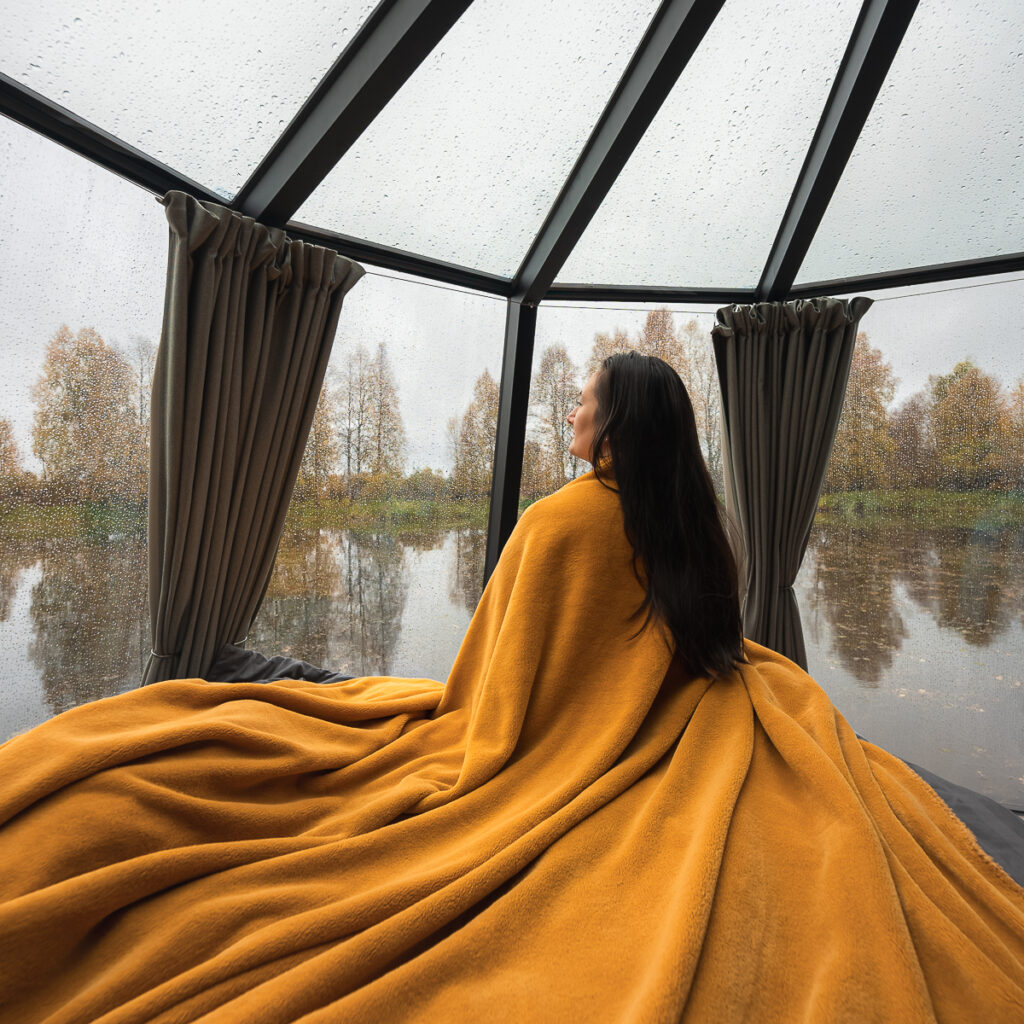
Most people dream of visiting Rovaniemi when snow blankets the landscape and Christmas lights fill the air with magic. But having chased the Northern Lights in Abisko, Sweden, during winter before, I knew autumn would be the perfect time to visit the official hometown of Santa Claus. My September trip to Finnish Lapland confirmed it.
The temperatures haven’t dropped to brutal winter lows yet, the Northern Lights are already active, and you’ll experience “Ruska”—the Finnish word for the breathtaking autumn phenomenon when entire forests explode into vibrant reds, yellows, and oranges. The best part is you’ll avoid the winter crowds and premium pricing while still experiencing the authentic Arctic Circle.
After spending a week exploring Rovaniemi in autumn, I’m sharing everything you need to plan your own shoulder-season adventure!
Quick Guide:
- Best time to visit: September through early October
- Recommended length: 5-7 days minimum
- Must-do experiences: Northern Lights hunting, Ruska season hiking, Finnish sauna culture
- Where to stay: See my complete guide to where to stay in Rovaniemi for detailed hotel reviews
Why Visit Rovaniemi in Autumn?
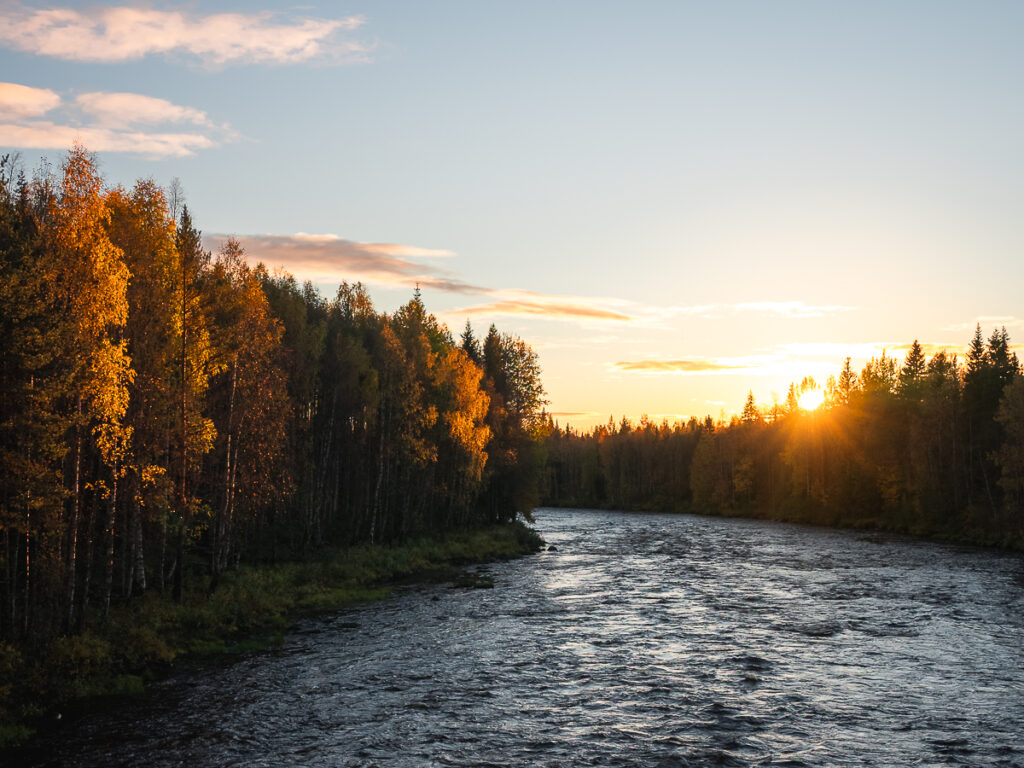
Autumn in Rovaniemi delivers unique advantages you won’t find during the peak winter season. The Northern Lights are already active from late August through early April, giving you your first chance to see them without enduring -30°C temperatures. The entire landscape transforms into what Finns call “Ruska”—vibrant fall colors that blanket not just the trees but even the ground in what’s known as “Maaruska,” creating a carpet of reds and yellows.
September temperatures hover around 5-10°C (40-50°F), which means you’re cool enough for cozy sweaters but warm enough to spend hours outdoors without extreme weather gear. Hotels and tours operate at off-season rates, and popular attractions feel peaceful rather than crowded. You’ll also participate in “Ruskaretki”, the beloved Finnish tradition of hiking specifically to admire fall foliage, something winter visitors never experience.
How Many Days Do You Need in Rovaniemi?
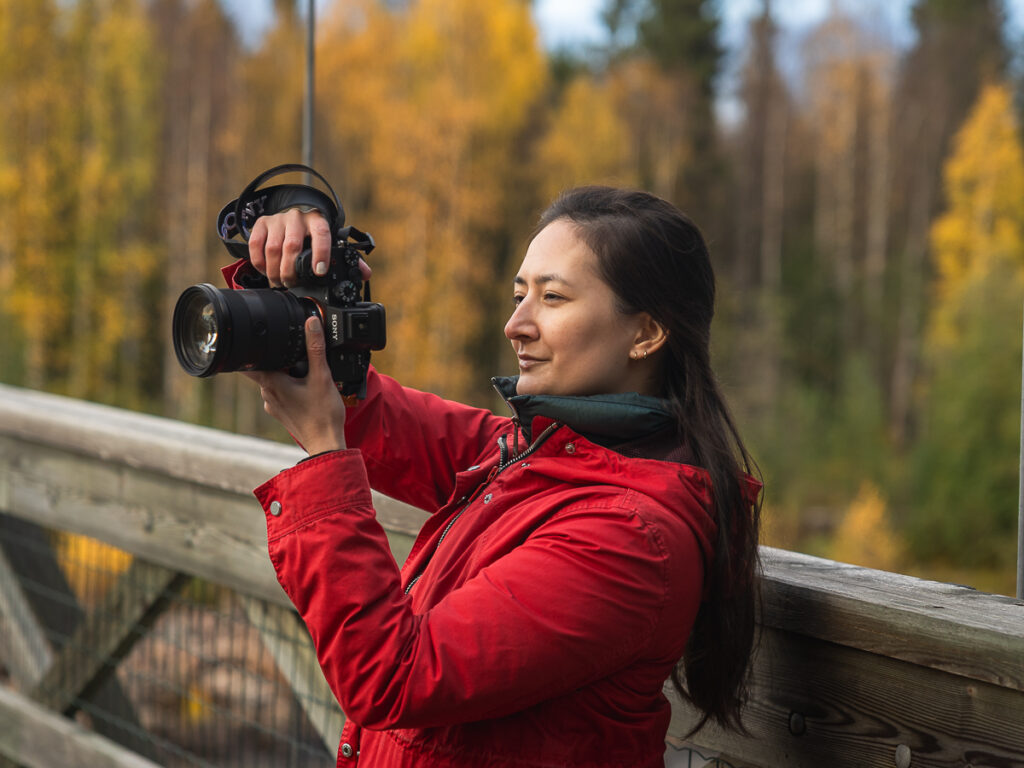
Plan for a minimum of 3-4 days if you only want highlights, but 5-7 days is ideal for the full autumn experience. I spent seven days in Rovaniemi, which gave me time to chase the Northern Lights west toward Sweden when local weather didn’t cooperate, experience different accommodations, and truly immerse myself in Finnish autumn culture rather than rushing through a checklist. The extra days made all the difference since Northern Lights hunting requires patience and backup nights when clouds roll in.
Things to Do in Rovaniemi in Autumn
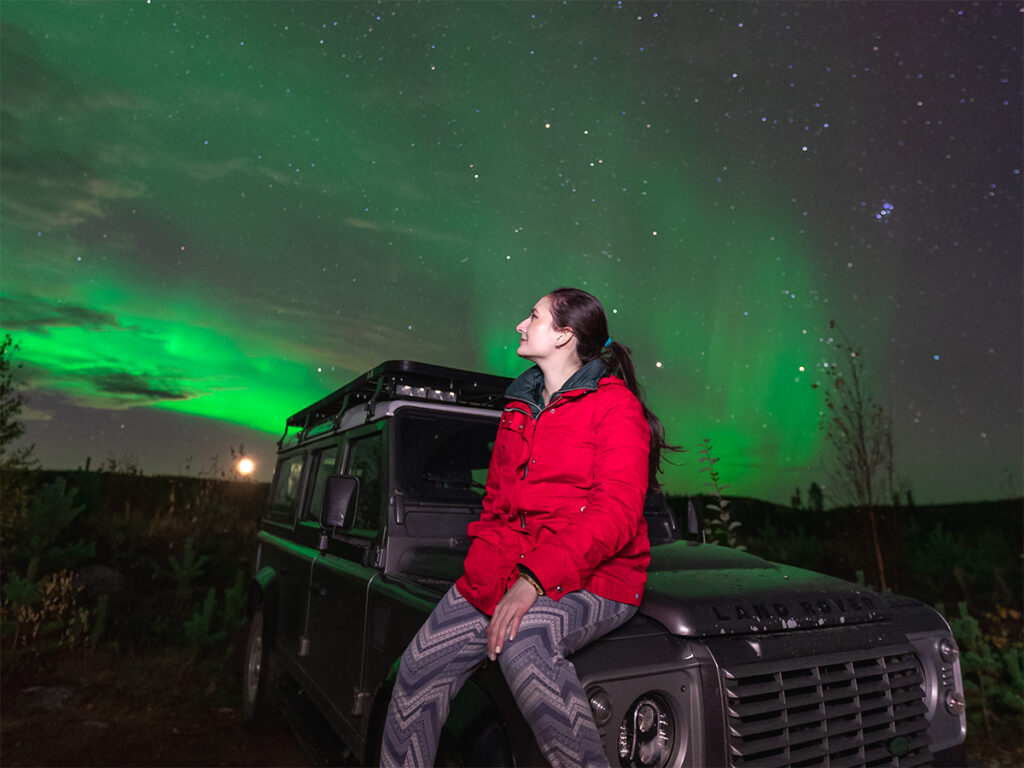
Chase the Northern Lights
While winter gets more attention, autumn is ideal for Aurora hunting because the lights typically show around the same time of night, which means longer nights in the cold are nothing more than for developing depression.
My Northern Lights experience mainly consisted of clouds that obscured the sky for most of my week in Rovaniemi, testing my patience. Rather than hoping the lights would come to me, I made a spontaneous decision to join a local aurora hunter in his rugged Defender and chase them west toward the Swedish border.
After driving two hours west, the sky finally cleared. Ethereal green ribbons swayed and shimmered overhead, reflecting off nearby lakes and creating an otherworldly scene. In one really cool moment, I captured a shot with the crescent moon, Milky Way, and Aurora all dancing together.
The statistical reality: Being in the Arctic Circle, you’re statistically guaranteed to see the Northern Lights at least once if you stay longer than 3 days—weather permitting.
Practical tips for Northern Lights hunting:
- Download aurora forecast apps
- Be prepared to chase them—local weather might not cooperate, but clearer skies often exist an hour or two away
- Bring a tripod for photography
- Dress warmer than you think necessary—you’ll stand still for long periods
For detailed photography guidance, see my complete guide on how to photograph the Northern Lights in Lapland for camera settings, composition tips, and equipment recommendations.
Bonus Experience: Standing on the Finnish-Swedish Border
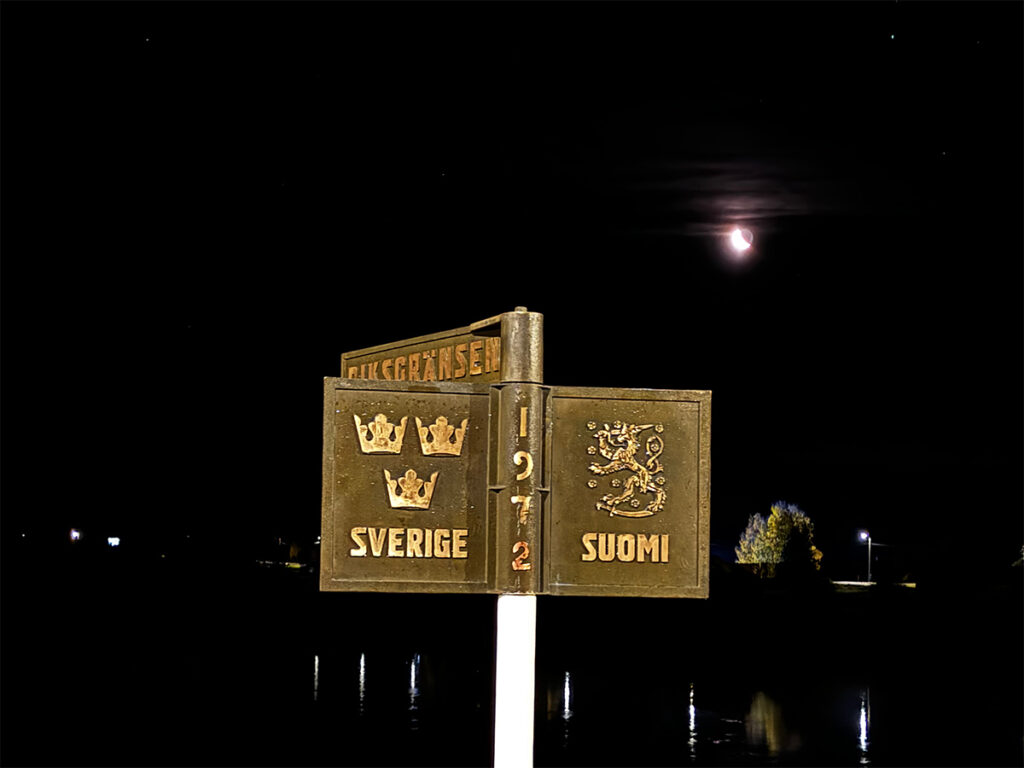
After a seven-hour chase that literally ended with me standing on the Finland-Sweden border, rain returned for the next couple of days. But my final night in Rovaniemi brought clear skies and an encore performance. Within 12 hours, I captured everything I’d hoped for throughout the week.
Experience Ruska Season
What is Ruska? The Finns have a beautiful word for the autumn phenomenon when forests transform into brilliant colors. It’s not just the trees changing; even the ground undergoes what they call “Maaruska,” creating a vibrant carpet of reds and yellows.
Ruskaretki tradition: I quickly learned about this beloved Finnish tradition, essentially a hike specifically to admire fall foliage, but I didn’t have time to participate due to the crummy weather.
Foraging culture: Foraging is a huge part of local autumn life. Though I didn’t get to participate directly in berry picking, I made up for it by consuming my body weight in lingonberry jam. I also tried cloudberry for the first time—a tart, golden berry that grows in Arctic bogs. And don’t get me started on Finnish blueberry juice, which puts American versions to shame.
Where to find Ruska:
- Hiking trails around Rovaniemi (ask locals for current best spots)
- Around the three hotels I stayed at (see accommodation section)
Ruska usually peaks in Early September, typically offering maximum color, though exact timing varies by year based on weather patterns.
Visit Santa Claus Village (Off-Season)
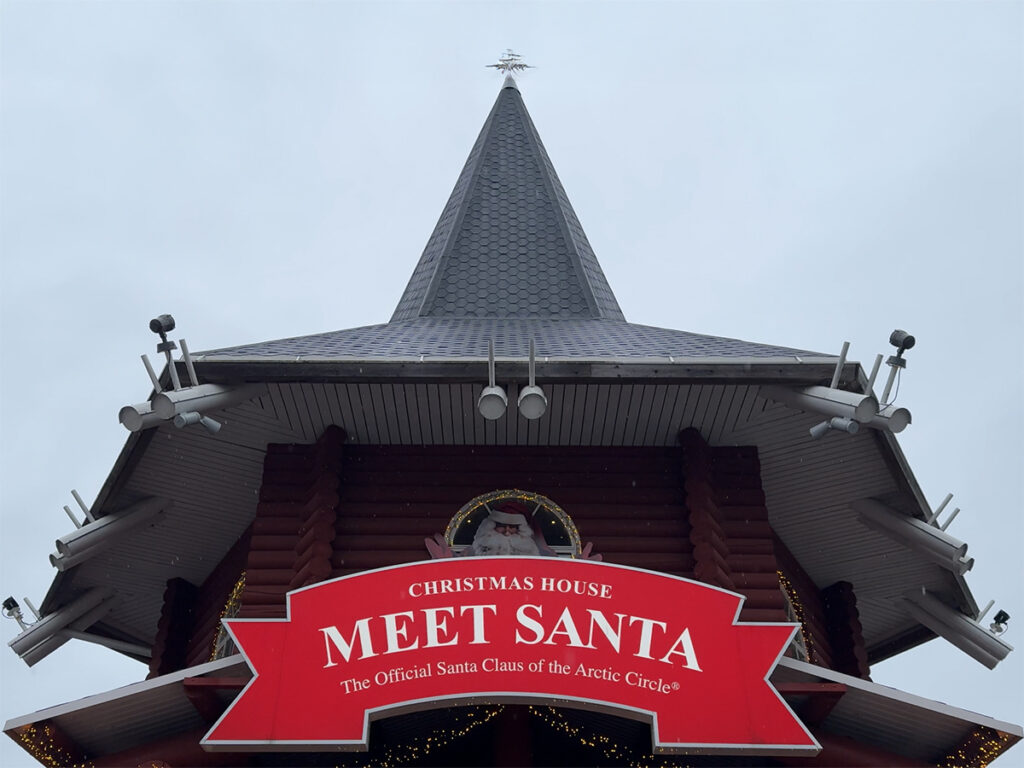
During my autumn visit, Santa Claus Village was eerily quiet. Rows of empty souvenir shops, a distinct lack of jingle bells in the air, and I could walk right up to attractions without queuing. Come December, though, this place transforms into something akin to Copenhagen’s Tivoli Gardens, buzzing with excited visitors from around the world.
What’s still operating in autumn:
- Standing on the Arctic Circle line—the invisible boundary where the midnight sun rules in summer and polar nights descend in winter
- Sending postcards to friends and family from Santa’s official post office (they arrive stamped from Santa’s Village!). I couldn’t resist sending some postcards. I mean, who wouldn’t want to receive mail from Santa’s Village?
- Browsing the Christmas shops in peaceful solitude
Practical info:
- Free to enter and explore
- Located about 8km north of Rovaniemi city center
- Easy bus access from downtown
- Allow 2-3 hours for a thorough visit
Experience Finnish Sauna Culture
No visit to Finland would be complete without experiencing a traditional sauna. With 2 million saunas for 5 million citizens, it’s clearly a cornerstone of Finnish culture. While most locals visit public saunas, I was fortunate to enjoy private sessions at two of my accommodations. This is because I partnered with each of them while I was there, and they wanted me to experience this cultural tradition. The intense heat of a wood-fired sauna followed by an exhilarating plunge into a crisp, cool lake. It’s an invigorating ritual that epitomizes Finnish wellness culture.
Why autumn is perfect for sauna: The outdoor temperatures (around 5-10°C ) create the ideal contrast with the sauna’s heat. Plunging into an already cold lake in September is refreshing rather than torturous, like it would be in December-February.
Where to experience it:
- Most hotels offer private saunas (see my Where to Stay in Rovaniemi guide)
- Public saunas in Rovaniemi city center
Try Ice Sculpting at Arctic SnowHotel
A unique autumn activity that only Arctic Snowhotel & Glass Igloos in Rovaniemi offers guests is the opportunity to try ice sculpting. Inside a specialized refrigerator maintained at -15°C (5°F), you can craft frozen masterpieces from substantial blocks of ice.
Each autumn evening, a pop-up ice bar emerges serving cocktails in pure ice glasses—previewing their signature winter attraction, the SnowHotel, which welcomes guests from November through early spring.
I was pleasantly surprised at how much fun I had. The instructor guides you through basic techniques, and you leave with some memories and numb fingers.
Where to stay in Rovaniemi
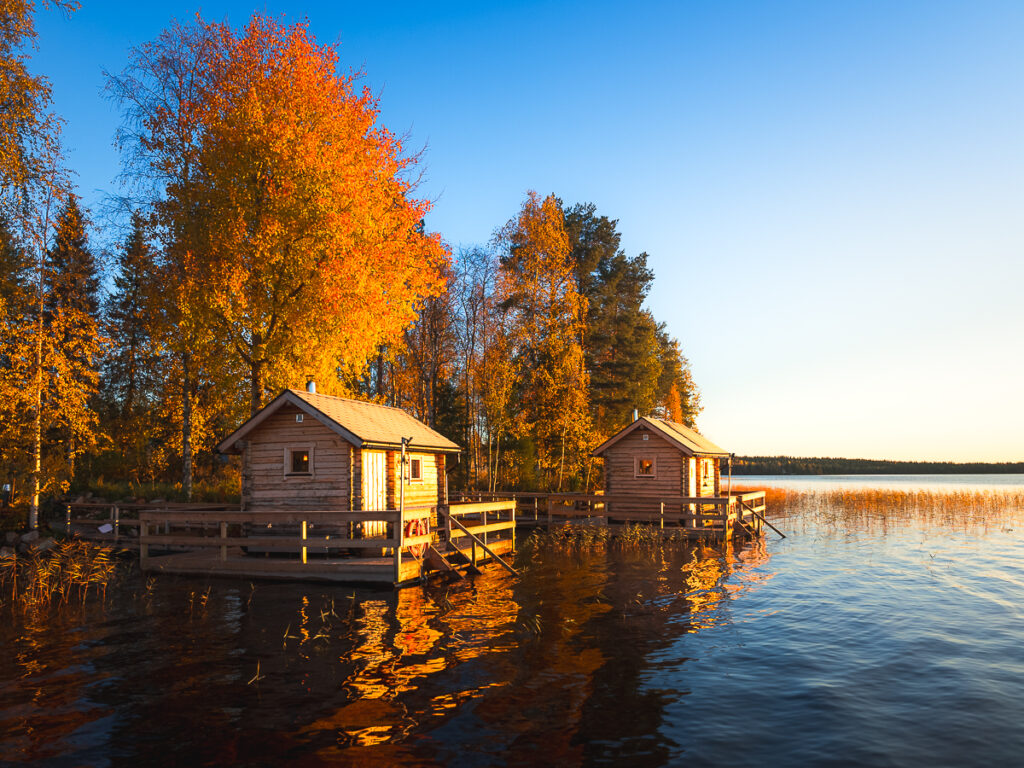
During my week in Rovaniemi, I experienced three distinct accommodations that showcase different aspects of Finnish Lapland hospitality. Each offers unique advantages for autumn visitors.
Invisible Forest Lodge
Perfect for those seeking seclusion in nature. The boutique “invisible” suite cabins feature private saunas and outdoor hot tubs. The Aurora Hut Igloos offer novel glamping with glass domes for Northern Lights viewing. Be forewarned, they’re compact, especially the toilet area. I much preferred the suite cabin.
Arctic SnowHotel & Glass Igloos
Home to what might be the world’s finest hotel breakfast buffet (seriously—the lingonberry crumble alone is worth it). The glass igloos feature 360-degree transparent roofs specifically designed for Aurora viewing, plus they offer the unique ice sculpting experience.
Apukka Resort
One of the most impressive places I’ve stayed anywhere. The two-story Kammi Glass Igloo Suites feature strategically placed beds under glass domes. The Floating Sauna & Arctic Swimming experience perfectly embodies Finnish wellness traditions.
For a more in-depth review of these hotels, see my full guide to where to stay in Rovaniemi.
Practical Planning Information to Rovaniemi
Getting to Rovaniemi: Rovaniemi Airport receives direct flights from Helsinki. Most hotels offer shuttle service, or take a taxi to get to the city center.
Getting around: You don’t need a rental car if you’re booking guided Northern Lights tours and staying near the city center. However, a car provides flexibility for chasing the Northern Lights independently (like I did—joining a local aurora hunter’s Defender for the chase west). Santa Village is accessible by bus from downtown.
What to pack: Layer for 5-10°C temperatures—thermal base layers, warm mid-layers, waterproof outer jacket, warm hat and gloves, waterproof hiking boots. Bring a tripod and extra camera batteries if photographing the Northern Lights (the cold drains them fast).
Frequently Asked Questions About Rovaniemi in Autumn
Q: When is the best time to visit Rovaniemi in autumn?
A: Early September offers peak Ruska colors and active Northern Lights with the mildest temperatures. Late September into early October provides longer nights for aurora viewing, but cooler weather and fading fall colors.
Q: Can you see the Northern Lights in Rovaniemi in autumn?
A: Yes! The Northern Lights are active from late August through April. Autumn actually offers excellent viewing opportunities without brutal winter temperatures. Statistically, stays longer than 3 days have high chances of seeing the aurora at least once, weather permitting.
Q: What is the Ruska season in Finland?
A: Ruska is the Finnish word for autumn foliage season when forests transform into vibrant reds, yellows, and oranges. “Maaruska” refers to the ground-level color changes. Finns traditionally practice “Ruskaretki”—hiking specifically to admire fall colors. Peak Ruska typically occurs in early September in Rovaniemi.
Q: Is Rovaniemi crowded in autumn?
A: No. Autumn is shoulder season with significantly fewer tourists than winter peak (December-March). Popular attractions like Santa Claus Village feel peaceful rather than crowded. Hotels and tours operate at lower capacity, offering a more intimate Arctic experience.
Q: How cold is Rovaniemi in September?
A: September temperatures in Rovaniemi typically range from 5-10°C (40-50°F) during the day, dropping to near-freezing at night.
Q: Do you need a car in Rovaniemi?
A: It’s ideal, but not necessary. City center attractions and Santa Village are accessible by bus or taxi. However, a car provides flexibility for chasing Northern Lights and exploring Ruska locations independently.
Q: What Finnish foods should I try in Rovaniemi?
A: Don’t miss lingonberry jam, cloudberries (tart golden Arctic berries), and Finnish blueberry juice. The breakfast buffets at Rovaniemi hotels showcase excellent local cuisine.
To keep up to date with everything I share, follow along on my social media and read up on what camera gear I use when I travel.
Leave a Reply Cancel reply
© Erin Donahue Creative LLC, All Rights Reserved
Terms of Service & Privacy Policy